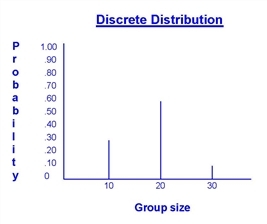
Discrete distributions are characterized by a finite set of outcomes, together with the probability of obtaining each outcome. In the following example, there are three possible outcomes for the group size: 30% of the time the group size will be 10, 60% of the time the group size will be 20, and 10% of the time the group size will be 30.

One way to represent a discrete distribution is by its probability mass function, listing the possible outcomes together with the probability of observing each outcome. A probability mass function for the example above could be expressed as follows (with G representing the group size).
G 10 20 30
P(G) .30 .60 .10
An alternate way to represent a distribution is through a cumulative distribution function, listing each possible outcome together with the probability that the observed outcome will be less than or equal to the specified outcome. A cumulative distribution function for the example above could be expressed as follows.
G 10 20 30
P(G) .30 .90 1.0
In the next example, the number of parts are grouped into a batch according to a user distribution.
Process Table
|
Entity... |
Location... |
Operation (min)... |
|
EntA |
Loc1 |
GROUP Dist() AS Batch |
|
Batch |
Loc1 |
WAIT 10 min |
Routing Table
|
Output... |
Destination... |
Rule... |
Move Logic... |
|
|
|
|
|
|
|
|
1 |
Batch |
Loc2 |
FIRST 1 |
MOVE FOR 5 |



|
© 2012 ProModel Corporation • 556 East Technology Avenue • Orem, UT 84097 • Support: 888-776-6633 • www.promodel.com |